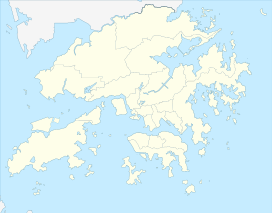Tai Mo Shan
| Tai Mo Shan | |
|---|---|
 Tai Mo Shan, viewed from Tai To Yan | |
| Highest point | |
| Elevation | 957 m (3,140 ft) Hong Kong Principal Datum |
| Geography | |
| Location | Centre of the New Territories, |



Tai Mo Shan (Chinese: 大帽山; pinyin: Dàmàoshān / Dàmào Shān; Cantonese Yale: daaih mouh sāān; lit. 'Big Hat Mountain'; is the highest peak in Hong Kong, with an altitude of 957 m. It is located at approximately the geographical centre of the New Territories.
The area surrounding Tai Mo Shan is a known as Tai Mo Shan Country Park, which covers an area of 14.40 km². It is located to the north of Tai Lam Country Park.
Geology
Tai Mo Shan was once a volcano and has long been extinct, so it is made up of volcanic rocks from the Jurassic age. Today a small hill that is part of Tai Mo Shan known as "Kwun Yum Shan" still vents warm air though cracks in the rocks that lead all the way to the mantle. The holes that exhale warm air are known as "hot pots", when the surface temperature is cold, and the warmth of the expelled air is clearly discernible is referred to by locals as "dragon's breath". If the air temperature at the summit is 6 degrees Celsius, then the air emerging from the interior of Kwun Yum Shan is somewhere between 13 and 21 degrees Celsius. These "hot pots" are now just mild remnants of the intense superheated steam vents of the volcanic past[1] The volcanic rocks are mainly coarse ash crystal tuff.[2] To the northwest, the west and the south of the peak, the valleys contain large deposits of colluvium. The upper slopes are distinctly "ribbed", as is especially evident after a hill fire. These are stone terraces, running obliquely downhill to the valleys. Due to the height of the mountain, it is claimed to be Hong Kong's most misty area, as it is often covered in clouds. In summer it is frequently covered with cumulus clouds, especially on rainy days, and in winter stratus clouds and fog often cover the peak.
It is rather easy to hike to the peak as there is a road all the way at a comfortable gradient. People actually cannot access the highest point on Tai Mo Shan, as it is occupied by a Hong Kong Observatory (ex-RAF) weather radar station.
Vegetation
There are forest plantations in the southeastern part of the park. Limited by climatic and geographic factors, these plantations end at the 550 metre contour, above which shrubs and grasses dominate.
In the past, Tai Mo Shan was famous for a type of green tea, called mist or cloud tea, which grew wild on the mountain side. Occasionally, local people can still be seen picking the tea shoots for brewing green tea.
More than 1500 species of plants have been recorded in Tai Mo Shan including 27 species of native wild orchids, the protected Chinese Lily (Lilium brownii) which mostly grows on the east side of the Mountain, 24 species of native ferns, including tree ferns, of which a total of only 4 tree ferns species have been recorded around the entire mountain, 19 species of native grasses, and 7 species of native Bamboos. Camellia sinensis var. waldenae (formerly Camellia waldenae) are also found on the mountain.
A few types of wild Orchids also grow in the streams of Tai Mo Shan including the Chinese Pholidota Orchid, Hong Kong's most common orchid, and the Bamboo Orchid, so called because of a distinct stem that looks like bamboo, which also grows in the streams of Tai Mo Shan.
During the Japanese occupation of Hong Kong in World War II, most of the trees in the park were cut down and extensive reafforestation was carried out after the war. Trees that were planted are mostly non-native such as: Pinus massoniana, Acacia confusa, Lophostemon confertus, Paper Bark Tree. The area has now become one of the major forest plantations in Hong Kong.
Wildlife
Some mountain birds and rare species of snakes and butterflies breed here. There are also freshwater crabs, feral dogs, feral cats, oxen and wild boar.
Places of interest
A series of barbecue and picnic sites are provided along Route Twisk, the Shek Kong - Pat Heung catchwater and the Tuen Mun catchwater.
The Rotary Park at Tai Mo Shan is especially popular. Tourist groups often come here for a brief stop to enjoy the panoramic view, on a clear day even Lantau and its adjacent islands can be seen. Tai Mo Shan Visitor Centre is located not far away from the carpark, along Tai Mo Shan Road, which leads to the weather station on the top of the mountain.
History
In 1986, a 34 hour blaze destroyed 282,500 trees at Shing Mun and Tai Mo Shan and ravaged 7.40 km² of countryside.
See also
- Country parks and conservation in Hong Kong
- Geography of Hong Kong
- List of areas of Hong Kong
- List of mountains, peaks and hills in Hong Kong
- Kadoorie Farm and Botanic Garden
Notes and references
- ^ "8 Mesozoic Post-Volcanic and Tertiary Sedimentary Rocks". CEDD. Retrieved 20 December 2008.
- ^ R.J. Sewell, S.D.G. Campbell, C.J.N. Fletcher, K.W. Lai & P.A. Kirk (2000). The Pre-Quaternary Geology of Hong Kong. Government of Hong Kong SAR. ISBN 962-02-0299-6.
{{cite book}}: CS1 maint: multiple names: authors list (link)
- Initial text based on information provided by the Hong Kong Agriculture, Fisheries and Conservation Department (AFCD), under the provision that the re-dissemination or reproduction is for non-commercial use. [1]

